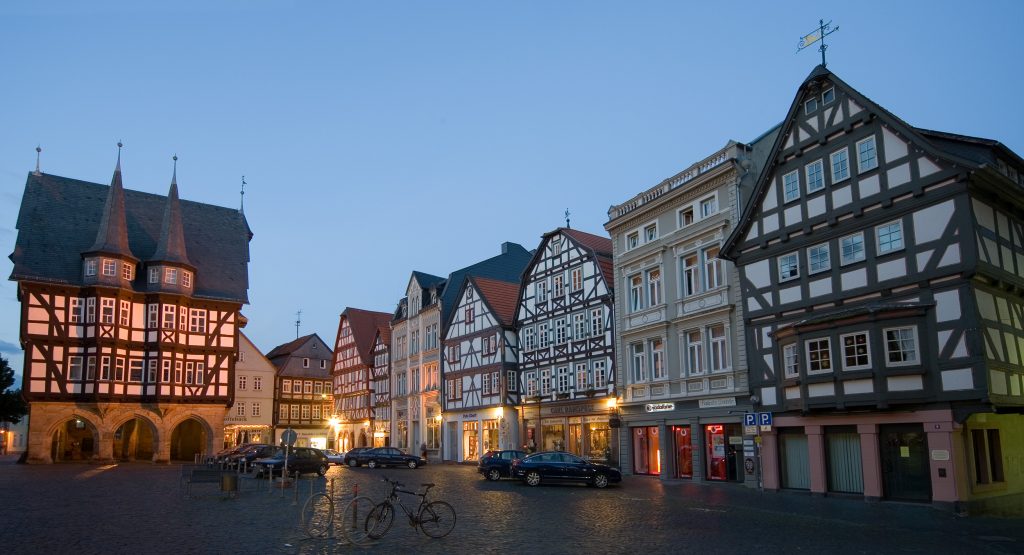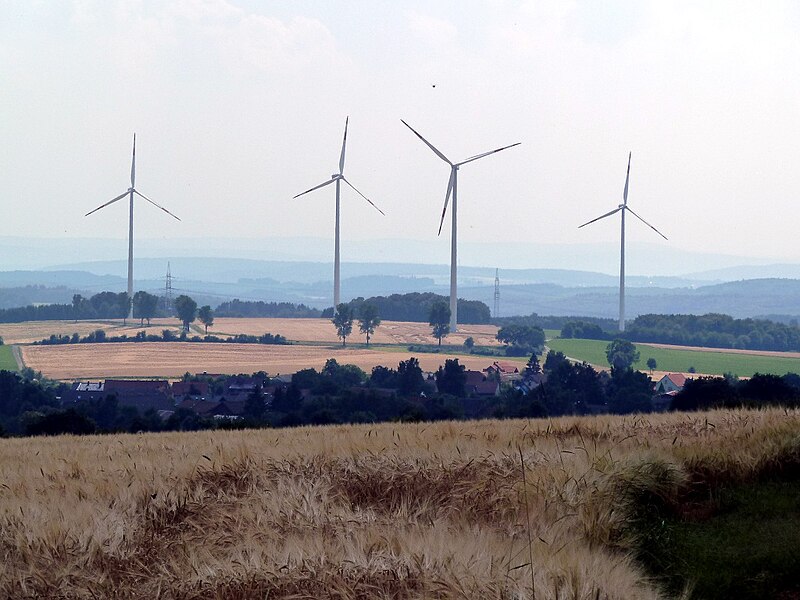Figure 1. Typical landscape with hedges and small villages in between near Schotten, Germany (UuMUfQ, CC BY-SA 3.0 via Wikimedia Commons, 2020).
by Hjördis Dall
The Vogelsberg, one of the oldest volcanic regions in Central Europe, presents itself not only as a geologically fascinating area but also as a rich cultural landscape where tradition and sustainability blend. Sometimes even harmoniously.
A cultural landscape with history
Located approximately 60 km northeast of Frankfurt, the gentle hills and extinct volcanoes of this low mountain range in Hesse, Germany, bear witness to millennia of geological evolution, while centuries-old agricultural practices and mining activities have shaped the landscape. Here, one can find extensive forests with numerous archaeological sites and historical landscape elements such as parallel terraces, dry stone walls and hedgerows. In addition, historical farms, ponds, traditional orchards, structured open land, heathlands, and expansive meadows adorn the region (Bundesamt für Naturschutz, 2022).

About this Blog series & the Heriland Blended Intensive Programme
The Blogs in this series (March-July 2024) were written by graduate students and early career professionals who participated in the Heriland Blended Intensive Programme “Heritage and the Planning of Landscapes” in October 2023 in Amsterdam, The Netherlands.
Are you interested in participating in the next iteration of the Heriland Blended Intensive Programme, “Heritage and Landscape Futures”, in Gothenburg, Sweden, in October 2024?

In the past, the landscape underwent changes due to land consolidations and evolving agricultural practices. Nowadays, many elements of the cultural landscape in the Vogelsberg are under pressure due to the increasing demand for agricultural intensification and the succession struggles of smaller farms. Additionally, demographic shifts are affecting the Vogelsberg-region, which has the lowest population density in Hesse (Region Vogelsberg e. V, 2022). Also, global climate changes exert a significant influence on the region. However, recent developments aim to address these issues, including its designation in November 2020 as a ‘National Geopark’ and various projects promoting cultural and political education. Some of the historical village cores and specific monuments are listed as cultural heritage sites.
While the entire Vogelsberg is not registered as a historical cultural landscape under UNESCO, efforts are nevertheless being made to develop the area comprehensively. Initiatives such as the Local Development Strategy (Region Vogelsberg e. V., 2022) and inclusion in the EU Funding Strategy LEADER Regions 2023-2027 demonstrate this commitment. The region is particularly proactive in implementing protective measures aimed at safeguarding the national natural heritage, which includes the establishment of one of Germany’s oldest nature parks, the “Naturpark Hoher Vogelsberg” and the Vogelsberg Large-Scale Nature Conservation Project (Wagner et al., 2015). These initiatives seek to foster sustainable connections between nature conservation, recreational opportunities and the preservation of the unique cultural landscape. For example, traditional livestock farming, alongside other methods, is sometimes used in preserving the hedgerow landscapes, which have been shaped over centuries by extensive grazing.
Yet, the Vogelsberg offers more than just beautiful landscapes.
Making the already significant region even more noteworthy is the blend of tradition and sustainability, shaping a distinctive cultural landscape.
Connecting Landscape Conservation and Renewable Energy
Living in Hesse, I’ve noticed that while the Vogelsberg region is well-known locally, many are unaware of its pioneering role in sustainable energy and nature conservation.
In the 1990s, the Vogelsberg even had one of Hessen’s first municipal wind parks, which involved a community participation company (HessenEnergie, 2024). Initially, there was little resistance to the construction of wind turbines, as wind power was perceived as an environmentally friendly alternative that integrated well with the surroundings. Moreover, involving citizens in the economic aspects of energy projects often leads to a more positive acceptance of the energy transition and the opportunity for citizens to participate in the energy transition, not only as consumers but also as owners, can even further advance towards a fairer energy system (Pellegrini-Masini, 2020).

Therefore, it seems like, in this area, nature conservation doesn’t automatically conflict with the production of renewable energy.
In recent years, however, the situation has evolved.
An increasing number of wind turbines were planned and built, with many designated areas being developed, and additional wind turbines in the pipeline. Some areas may even find themselves almost entirely surrounded by these structures (GDI Vogelsberg, 2024). These developments have not occurred without controversy in the region. Despite the general societal consensus in Germany towards wind turbines remaining positive. According to a survey by the Wind Energy Agency (FA Wind, 2022), it appears that there are increasing reports of protests against planned wind farms. In these protests, various concerns have been raised. Some are worried about alterations to the landscape, some fear potential impacts on historical heritage, and some even harbour concerns about the region’s appeal to potential new residents.
But how did this shift in the perception of wind turbines in the Vogelsberg region come about? The initial acceptance and apparent harmony between wind power and the surrounding landscape transformed into growing resistance and controversial debates. A closer examination reveals some intriguing aspects.
Like many other regions, the Vogelsberg has undergone planning and development processes. Site assessments for planning purposes were carried out, and wind priority areas were designated in the Middle Hessen Regional Plan (Regierungspräsidium Gießen, 2021). In these processes, undoubtedly, landscape evaluations were conducted to identify the most suitable locations for wind turbines.

However, amidst the multitude of plans and initiatives, there appears to be a potential inclination to emphasise particular aspects. This prompts consideration as to whether the region may be experiencing an overload of initiatives or if the planning process needs to adopt a more holistic approach. Perhaps taking into account the historical and cultural character of the region, as well as the concerns and desires of local communities, would have been beneficial. Was there sufficient consideration of how wind turbines could alter the landscape and influence the historical heritage? Were the interests of the people living in this unique cultural landscape adequately considered? These are essential questions that emphasise the significance of a comprehensive approach. One that considers not only technical and economic aspects on the one hand and natural aspects on the other hand but also cultural, historical, and social factors.
The Vogelsberg region faces the challenge of striking a balance between sustainability and preserving its historical cultural landscape. It may be that methods like Historical Landscape Characterization (HLC) and the UNESCO Recommendation on the Historic Urban Landscape (HUL) approach could be essential tools in this endeavour.
Historical Landscape Characterization (HLC) is a useful tool for preserving the historical character of landscapes, encompassing their entire evolution beyond individual monuments. It enables tracing the region’s development over time, including the impact of traditional practices, historical events and modern developments, offering crucial insights for preservation efforts (Aldred & Fairclough, 2003). Utilising HLC alongside the principles of the Historic Urban Landscape (HUL) approach could therefore greatly enhance preservation efforts in the Vogelsberg, since this approach recognizes urban areas as layered accumulations of cultural and natural values, encompassing beyond traditional centres to include broader contexts. It emphasises understanding the urban environment comprehensively, promoting conservation, sustainable development, and social diversity. (UNESCO, 2011)
Hence, the adoption of these methods presents a promising avenue for addressing the challenge of sustainability while safeguarding Vogelsberg’s cherished historical and cultural heritage.
Bibliography
Aldred, O. and Fairclough, G. (2003). Historic Landscape Characterisation Taking Stock of the Method: The National HLC Method Review carried out for English Heritage by Somerset County Council”. N.p.p: English Heritage and Somerset County Council
Arbeitsgemeinschaft GDI Vogelsberg: Windenergieanlagen und Windvorrangebiete. (2024). [Online]. Available at: https://www.geoportal-vogelsberg.de/de/Windenergie.html
Bundesamt für Naturschutz. (2022). Bedeutsame Landschaften In Deutschland – Vogelsberg. [Online]. Available at: https://www.bfn.de/bedeutsame-landschaft/vogelsberg
FA Wind .(2022). Umfrage zur Akzeptanz der Windenergie an Land. (2022), Berlin. [Online]. Available at: https://fachagentur-windenergie.de/fileadmin/files/Veroeffentlichungen/Akzeptanz/FA_Wind_Umfrageergebnisse_Herbst_2022.pdf
HessenEnergie Gesellschaft für rationelle Energienutzung. (2024): Bürgerbeteiligung, mehr als ein Versprechen. [Online] Available at: https://www.hessenenergie.de/leistungen/planung-neuer-windenergieanlagen/buergerbeteiligung-mehr-als-ein-versprechen/
Hessisches Ministerium für Umwelt, Klimaschutz, Landwirtschaft und Verbraucherschutz . (2022). Hessens Leader-Regionen 2023-2027. [Online]. Available at: https://umwelt.hessen.de/sites/umwelt.hessen.de/files/2022-11/121022_hmuklv_leader-regionen_web_pw.pdf
Pellegrini-Masini, G. (2020). Wind Power and Public Engagement: Co-operatives and Community Ownership. United Kingdom: Taylor & Francis.
Regierungspräsidium Gießen als Geschäftsstelle der Regionalversammlung Mittelhessen. (2021). Teilregionalplan Energie Mittelhessen 2016/2020. Steckbriefe. [Online]. Available at: https://rp-giessen.hessen.de/sites/rp-giessen.hessen.de/files/2022-07/trpem_2016_2020_steckbriefe_vrg_we.pdf
Region Vogelsberg e. V.: Lokale Entwicklungsstrategie LEADER-Region Vogelsberg. [Online]. Available at: https://www.region-vogelsberg.de/wp-content/uploads/2022/12/2022-11-30_LES-VB-2022-2.pdf
United Nations Educational, Scientific and Cultural Organization (UNESCO). (2011). Recommendation on the Historic Urban Landscape. [Online] Available at: https://whc.unesco.org/uploads/activities/documents/activity-638-98.pdf
Wolfgang Wagner, Alexander von Küchler, Benjamin Hill, Marion Löhr-Böger, Michael Uebeler, Joachim Schönfeld. (2015). “The Vogelsberg large-scale conservation project.“ In Natur und Landschaft – Zeitschrift für Naturschutz und Landschaftspflege. [Online]. Available at: https://www.pgnu.de/images/veroeffentlichungen/2015_11_510_Wagner_978-3-00-153367-8_NSGP_Vogelsberg.pdf
About the author
Hjördis Dall is a student in Cultural Heritage in Construction at the RheinMain University of Applied Sciences in Wiesbaden, Germany. This Blog post is inspired by her travels, and exploration of local landscapes, and based on her participation in the Heriland Blended Intensive Programme on ‘Cultural Heritage and the Planning of European Landscapes’ in October 2023.
Contact Hjördis Dall: hjoerdis.dall@web.de
About the National Parks Miniseries
During the Heriland Blended program Multispaces Living Lab, students worked on many themes, including National Parks. This post is the first of two proposal blog posts prepared by two different participants. Next week, we will have another proposal from the National Parks series.

